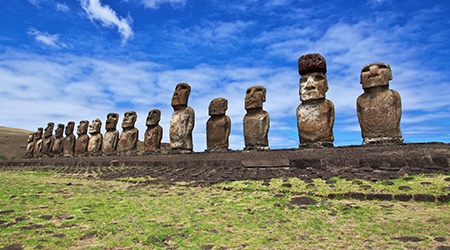1- National parks in Chile

Torres del Paine National Park is one of the most spectacular national parks in the country. As a world biosphere reserve, it has a lot of plant and animal species which, with its incredibly beautiful setting, has made it an almost unequalled destination for many hikers/backpackers, ecology-lovers and adventure sports men and women alike. In the park, you can see some native animals such as foxes, guanacos, huemul deer, pumas, and the massive Andean condor. If you would like to know see more of this park’s tourist attractions, you should visit the blue icebergs that break off from Grey Glacier, the Milodon Caves, and the ancient wall art along the Fauna Trail.

Easter Island, or Rapa Nui, is one of the most attractive places in the world. It is important to remark that this is one of the few places where its native -or pascuense- culture is still present, which the locals have maintained through their customs and traditions for centuries. In this park, there are more than 800 monumental stone statues, called Moai, being one of the most distinctive features of the island. However, the park also offers many marvelous views of the sea and a glimpse of the unique volcanic terrain.
2- Quantifiers?
2.1- What are quantifiers?
We use quantifiers when we want to give information about the number of something: how much/ how many. It is used before a noun.
Quantifiers can be used with both countable and uncountable nouns.
| Some (algunos / algunas) – any (alguno / alguna) – a lot of (muchos/as) – lots of (muchos/as) – enough (bastante/es)- more (más) – less (menos) – no / none (no, ninguno/a). |
Examples:
– There are some books on the desk.
– Have you read any of her other books?
– We saw a lot of small volcanoes.
– You don’t go out enough.
– He's got more friends than his sister.
– He earns less than you.
– I tried to get tickets, but there were none left.

|
Puedes contar dinero, leche, carne; pero para eso debes usar monedas, litros, kilos, vasos, etc. 3 kilos… of meat / 3 kilos de carne |
2.2- Countable and uncountable nouns
|
Countable Nouns Countable nouns have a singular and a plural form. In plural, these nouns can be used with a number- they can be counted: 2 books, 3 friends. Singular count nouns cannot be used alone-they must have a determiner: The English teacher, a wish, that book. |
Uncountable Nouns Uncountable nouns can only be used in singular form. These nouns cannot be used with a number- they can't be counted. I have a lot of money. (Not 1000 money) I drink a lot of milk. (Not 5 milk) |
|
We use there is and there are to say that something exists: • We use there is for singular and uncountable nouns. La traducción en español de estas expresiones es “hay”. |
2.3- Quantifiers used with countable nouns
Many (mucho): Expresa la idea de gran cantidad. Es utilizado sobre todo en frases negativas e interrogativas con el nombre contable en plural. Se puede usar “many” en frases afirmativas, aunque no es muy común. Normalmente, usamos otros cuantificadores como “a lot.”
Negative: There are not many tourists.
Interrogative: How many cats do you have
Affirmative: We have many friends.
Few / a few (poco, pocos): Expresan un número pequeño. Se usan sólo con nombres contables. Como hemos visto arriba, la opción de usar “few” o “a few” refleja la opinión sobre la cantidad expresada. “Few” describe la cantidad de forma negativa y “a few" la describe de forma positiva.
Interrogative: Do you have a few dollars
Affirmative: There are very few tourists here today.
2.4- Quantifiers used with uncountable nouns
Much (mucho): Como “many”, expresa la idea de gran cantidad y es utilizado sobre todo en frases negativas e interrogativas. La diferencia con “many” es que usamos “much” sólo con nombres incontables en singular. Se puede usar “much” en frases afirmativas, aunque sería más formal y no es tan común.
Negative: There is not much time.
Interrogative: How much money does he have?
Affirmative: We have so much to do!
Little / a little (poco, pocos): Expresan una cantidad pequeña y se usan sólo con nombres incontables. La opción de usar “little” o “a little” refleja una opinión sobre la cantidad. Si usas “a little", significa una opinión positiva sobre la cantidad y si usas “little” implica una opinión negativa.
Interrogative: Do you have a little money?
Affirmative: We have little time.
2.5- Questions about quantity
When we want to ask the quantity of something
| HOW MANY + COUNTABLE | HOW MUCH + UNCOUNTABLE |
| How forks are there? | How much orange juice is there ? |

